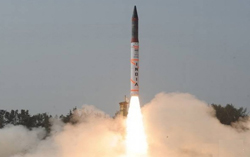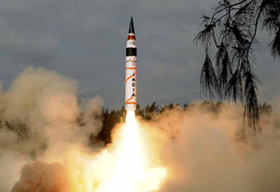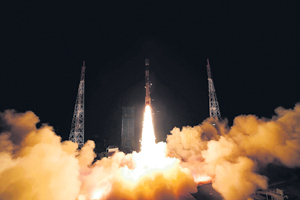December 2018 Science and Technology
Sakshi Education

- India successfully test-fires Agni-IV ICBM from Odisha coast
India successfully test-fired its nuclear-capable long-range Inter Continental Ballistic Missile Agni-IV, with a strike range of 4,000 km. The test was part of a user trial by the Army.
The strategic surface-to-surface missile was flight tested from the Integrated Test Range (ITR) at Dr Abdul Kalam Island off Odisha coast at 8.30 am.
Agni-IV missile is equipped with advanced Avionics, 5th generation On Board Computer and distributed architecture. It has the latest features to correct and guide itself for in-flight disturbances.
Ballistic missiles like Agni-I, II and III and Prithvi have already been inducted in the arsenal of the armed forces.
- Union Cabinet approves Indian Human Spaceflight programme
Union Cabinet has approved the Gaganyaan Programme with a demonstration of Indian Human Spaceflight capability to low earth orbit for a mission duration ranging from one orbital period to a maximum of seven days.
A human-rated GSLV Mk-lll will be used to carry the orbital module which will have necessary provisions for sustaining a 3-member crew for the duration of the mission.
The total fund requirement for the Gaganyaan Programme is within 10,000 crore rupees and includes the cost of technology development, flight hardware realization and essential infrastructure elements.
Two unmanned flights and one manned flight will be undertaken as part of Gaganyaan Programme.
- Centre brings booklet on cyber safety for school children
Home Ministry has brought out a booklet on cyber safety for school children to inform them about different aspects of cyber safety.
The booklet, titled 'A Handbook for Students on cyber Safety', also deals with the problems of cyber bullying, cyber grooming and email fraud. It advises teenagers against accepting friend requests from unknown people on social media.
The booklet explains various kinds of cyber crimes like identity theft, job fraud, email spoofing and how children can overcome them.
The information provided in the handbook is intended to create awareness among citizens especially students about various cyber threats that can impact them and ways to safeguard themselves against cyber crimes.
The booklet also provides details about various safeguards that can be adopted by children to protect themselves from cyber grooming.
- Countdown for the launch of India's communication satallite, GSAT- 7A begins today (18 Dec, 2018)

The Countdown for the launch of India's communication satallite, GSAT- 7A will begin on 18 December, 2018 at the Satish Dhawan Space Centre in Sriharikota, Andhra Pradesh. The Satellite will be launched onboard GSLV-F11 at 4:10 PM on 19 December, 2018.
While GSLV-F11 will inject the satellite into a Geosynchronous Transfer Orbit, it will be placed in its final Geostationary Orbit using the onboard propulsion system.
GSAT-7A, built by ISRO, will provide communication capability to users in Ku-band over the Indian region. The satellite will have a mission life of eight years.
- Countdown begins for launch of communication satellite GSAT-7A
The 26-hour countdown is progressing smoothly for the launch of GSLV F 11 carrying GSAT 7A at the Space research Centre Sriharikota. Officials said that the process of propellant filling of liquid strap-ons had begun.
The last launch of this year (2018) is a dedicated mission for updating and increasing the capability of the Country's defence forces.
GSLV F 11 will carry the 2250 kilogram GSAT 7A from Sriharikota at 4.10 pm on 19 December, 2018.
The rocket will spew out the satellite within 20 minutes after lift off from the second launch pad of the Satish Dhawan Space Centre. "GSAT 7A is ISRO's 35th communication satellite and it is the third mission in just over a month by the space agency.
The rocket, GSLV F 11 is the fourth generation launch vehicle with three stages. The four liquid strap-ons and a solid rocket motor at the core form the first stage. The second stage is equipped with a high thrust engine using liquid fuel.
The cryogenic upper stage forms the third and final stage of the vehicle. The satellite will be taken into the geostationary or circular orbit using the onboard propulsion system and it will take a few days after the separation from the launcher to reach its orbital slot.
The satellite is said to network-dependent warfare capabilities, enhancing its abilities to operate globally. ISRO had already launched GSAT 11, the heaviest communication satellite was launched from French Guiana on the 5th of this month.
- ISRO successfully launches GSAT-7A
GSLV-F11 successfully launched GSAT-7A, ISRO’s 39th communication satellite, on December 19, 2018 at 1610 hrs (IST) from the Second Launch Pad (SLP) of Satish Dhawan Space Centre SHAR, Sriharikota.
GSLV-F11 is the 13th flight of India’s Geosynchronous Satellite Launch Vehicle (GSLV) and its 7th flight with indigenous Cryogenic Upper Stage (CUS).
GSLV – F11 is ISRO’s fourth generation launch vehicle with three stages. The four liquid strap-ons and a solid rocket motor at the core form the first stage. The second stage of the vehicle is equipped with high thrust engine using liquid fuel. The Cryogenic Upper Stage forms the third and final stage of the vehicle.GSAT-7A
GSAT-7A with a lift-off mass of 2250 kg, is a geostationary satellite carrying communication transponders in Ku-band. The Satellite is built to provide communication capability to the users over the Indian region.
- India successfully test-fires Inter-Continental Ballistic Missile Agni-5
 The indigenously built Inter-Continental Ballistic Missile Agni-5 has been test-fired successfully from Abdul Kalam island under Chandipur Interim Test Range on 10 December, 2018.
The indigenously built Inter-Continental Ballistic Missile Agni-5 has been test-fired successfully from Abdul Kalam island under Chandipur Interim Test Range on 10 December, 2018.
This is the fourth successful test of this missile. Previously the test of Agni 4 was unsuccessful.
Having 17 meters length and 2 meters diameter the missile can hit the target from a distance of 5 thousand kilometres.
It can carry both nuclear and traditional weapons. The first test was conducted in 2012 from ITR Chandipur in Balasore district.
- India’s heaviest satellite GSAT-11 is aloft in space from Kourou
 As most of India slept, its heaviest and most advanced communication satellite, GSAT-11, was shot to space from a European spaceport in faraway South America.
As most of India slept, its heaviest and most advanced communication satellite, GSAT-11, was shot to space from a European spaceport in faraway South America.
The mission of the 5,854-kg giant 'bird' is to enable much faster Internet services than now to users down home over the next 15 years. GSAT-11 was launched from the Guiana Space Centre at Kourou in French Guiana at 2.07 a.m. IST on 05 December, 2018.
GSAT-11, described by the space agency as a giant satellite, is the heaviest ever built by ISRO. (Its next biggest is the GSAT-17, weighing 3,477 kg and which was also launched for ISRO in June 2017 by the same European launch operator Arianespace.
The space agency described GSAT-11 as a "forerunner in the series of advanced communication satellites with multi-spot beam antenna coverage" over the mainland and islands. "GSAT-11 will play a vital role in providing broadband services across the country. It will also provide a platform to demonstrate new generation applications."
- India successfully test-fires Inter-Continental Ballistic Missile Agni-5
 The indigenously built Inter-Continental Ballistic Missile Agni-5 has been test-fired successfully from Abdul Kalam island under Chandipur Interim Test Range on 10 December, 2018.
The indigenously built Inter-Continental Ballistic Missile Agni-5 has been test-fired successfully from Abdul Kalam island under Chandipur Interim Test Range on 10 December, 2018.
This is the fourth successful test of this missile. Previously the test of Agni 4 was unsuccessful.
Having 17 meters length and 2 meters diameter the missile can hit the target from a distance of 5 thousand kilometres.
It can carry both nuclear and traditional weapons. The first test was conducted in 2012 from ITR Chandipur in Balasore district. - Countdown for the launch of India's communication satallite, GSAT- 7A begins today (18 Dec, 2018)

The Countdown for the launch of India's communication satallite, GSAT- 7A will begin on 18 December, 2018 at the Satish Dhawan Space Centre in Sriharikota, Andhra Pradesh. The Satellite will be launched onboard GSLV-F11 at 4:10 PM on 19 December, 2018.
While GSLV-F11 will inject the satellite into a Geosynchronous Transfer Orbit, it will be placed in its final Geostationary Orbit using the onboard propulsion system.
GSAT-7A, built by ISRO, will provide communication capability to users in Ku-band over the Indian region. The satellite will have a mission life of eight years.
- Countdown begins for launch of communication satellite GSAT-7A
The 26-hour countdown is progressing smoothly for the launch of GSLV F 11 carrying GSAT 7A at the Space research Centre Sriharikota. Officials said that the process of propellant filling of liquid strap-ons had begun.
The last launch of this year (2018) is a dedicated mission for updating and increasing the capability of the Country's defence forces.
GSLV F 11 will carry the 2250 kilogram GSAT 7A from Sriharikota at 4.10 pm on 19 December, 2018.
The rocket will spew out the satellite within 20 minutes after lift off from the second launch pad of the Satish Dhawan Space Centre. "GSAT 7A is ISRO's 35th communication satellite and it is the third mission in just over a month by the space agency.
The rocket, GSLV F 11 is the fourth generation launch vehicle with three stages. The four liquid strap-ons and a solid rocket motor at the core form the first stage. The second stage is equipped with a high thrust engine using liquid fuel.
The cryogenic upper stage forms the third and final stage of the vehicle. The satellite will be taken into the geostationary or circular orbit using the onboard propulsion system and it will take a few days after the separation from the launcher to reach its orbital slot.
The satellite is said to network-dependent warfare capabilities, enhancing its abilities to operate globally. ISRO had already launched GSAT 11, the heaviest communication satellite was launched from French Guiana on the 5th of this month.
- ISRO successfully launches GSAT-7A
GSLV-F11 successfully launched GSAT-7A, ISRO’s 39th communication satellite, on December 19, 2018 at 1610 hrs (IST) from the Second Launch Pad (SLP) of Satish Dhawan Space Centre SHAR, Sriharikota.
GSLV-F11 is the 13th flight of India’s Geosynchronous Satellite Launch Vehicle (GSLV) and its 7th flight with indigenous Cryogenic Upper Stage (CUS).
GSLV – F11 is ISRO’s fourth generation launch vehicle with three stages. The four liquid strap-ons and a solid rocket motor at the core form the first stage. The second stage of the vehicle is equipped with high thrust engine using liquid fuel. The Cryogenic Upper Stage forms the third and final stage of the vehicle.GSAT-7A
GSAT-7A with a lift-off mass of 2250 kg, is a geostationary satellite carrying communication transponders in Ku-band. The Satellite is built to provide communication capability to the users over the Indian region.
- India successfully test-fires Agni-IV ICBM from Odisha coast

India successfully test-fired its nuclear-capable long-range Inter Continental Ballistic Missile Agni-IV, with a strike range of 4,000 km. The test was part of a user trial by the Army.
The strategic surface-to-surface missile was flight tested from the Integrated Test Range (ITR) at Dr Abdul Kalam Island off Odisha coast at 8.30 am.
Agni-IV missile is equipped with advanced Avionics, 5th generation On Board Computer and distributed architecture. It has the latest features to correct and guide itself for in-flight disturbances.
Ballistic missiles like Agni-I, II and III and Prithvi have already been inducted in the arsenal of the armed forces.
- Union Cabinet approves Indian Human Spaceflight programme
Union Cabinet has approved the Gaganyaan Programme with a demonstration of Indian Human Spaceflight capability to low earth orbit for a mission duration ranging from one orbital period to a maximum of seven days.
A human-rated GSLV Mk-lll will be used to carry the orbital module which will have necessary provisions for sustaining a 3-member crew for the duration of the mission.
The total fund requirement for the Gaganyaan Programme is within 10,000 crore rupees and includes the cost of technology development, flight hardware realization and essential infrastructure elements.
Two unmanned flights and one manned flight will be undertaken as part of Gaganyaan Programme.
- Centre brings booklet on cyber safety for school children
Home Ministry has brought out a booklet on cyber safety for school children to inform them about different aspects of cyber safety.
The booklet, titled 'A Handbook for Students on cyber Safety', also deals with the problems of cyber bullying, cyber grooming and email fraud. It advises teenagers against accepting friend requests from unknown people on social media.
The booklet explains various kinds of cyber crimes like identity theft, job fraud, email spoofing and how children can overcome them.
The information provided in the handbook is intended to create awareness among citizens especially students about various cyber threats that can impact them and ways to safeguard themselves against cyber crimes.
The booklet also provides details about various safeguards that can be adopted by children to protect themselves from cyber grooming.
Published date : 14 Dec 2018 11:51AM



















